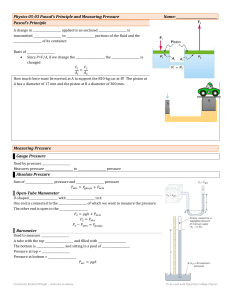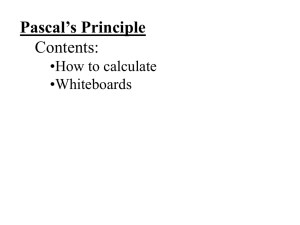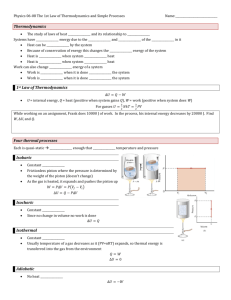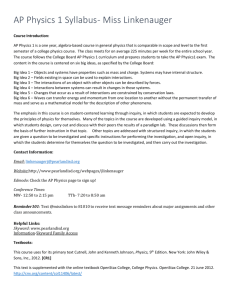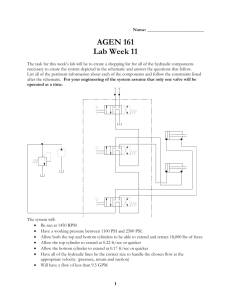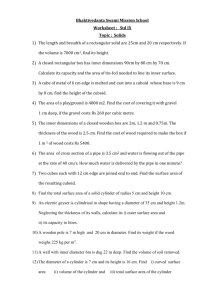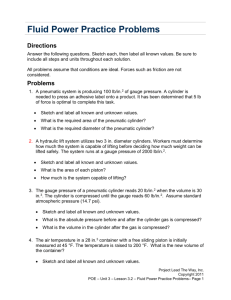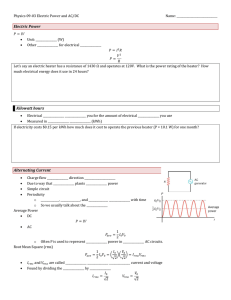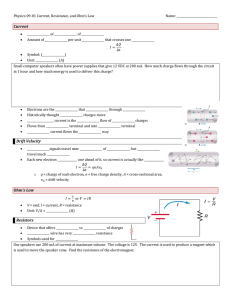Physics 05-03 Pascals Principle and Measuring Pressure
advertisement
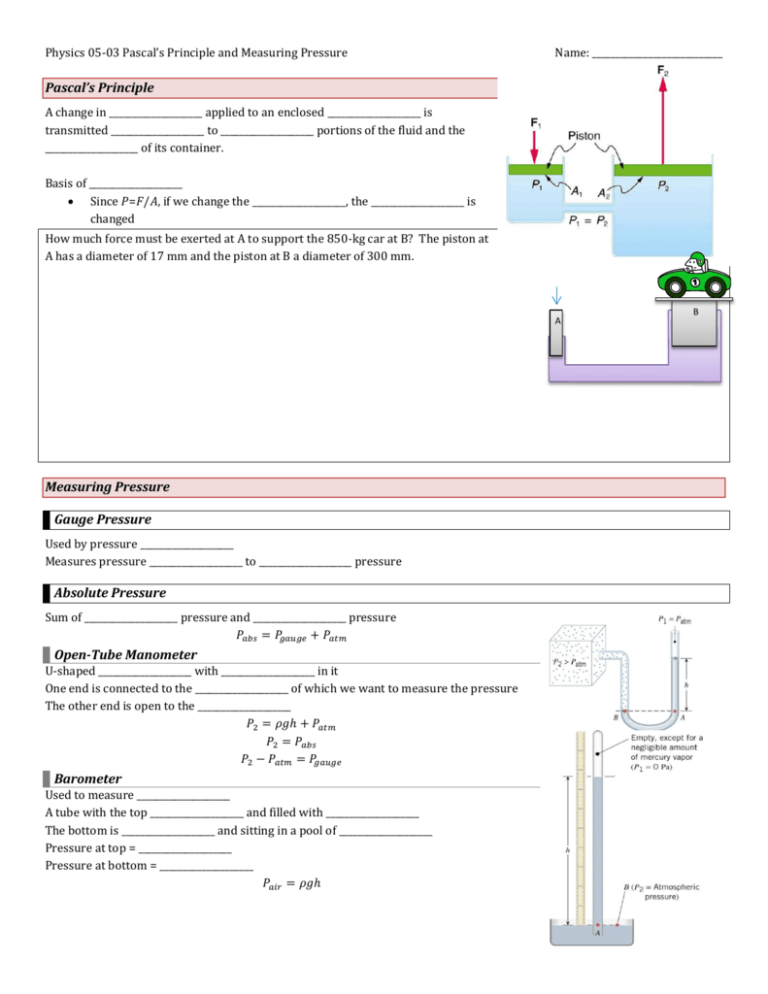
Physics 05-03 Pascal’s Principle and Measuring Pressure Name: ____________________________ Pascal’s Principle A change in ____________________ applied to an enclosed ____________________ is transmitted ____________________ to ____________________ portions of the fluid and the ____________________ of its container. Basis of ____________________ Since 𝑃=𝐹/𝐴, if we change the ____________________, the ____________________ is changed How much force must be exerted at A to support the 850-kg car at B? The piston at A has a diameter of 17 mm and the piston at B a diameter of 300 mm. A Measuring Pressure Gauge Pressure Used by pressure ____________________ Measures pressure ____________________ to ____________________ pressure Absolute Pressure Sum of ____________________ pressure and ____________________ pressure 𝑃𝑎𝑏𝑠 = 𝑃𝑔𝑎𝑢𝑔𝑒 + 𝑃𝑎𝑡𝑚 Open-Tube Manometer U-shaped ____________________ with ____________________ in it One end is connected to the ____________________ of which we want to measure the pressure The other end is open to the ____________________ 𝑃2 = 𝜌𝑔ℎ + 𝑃𝑎𝑡𝑚 𝑃2 = 𝑃𝑎𝑏𝑠 𝑃2 − 𝑃𝑎𝑡𝑚 = 𝑃𝑔𝑎𝑢𝑔𝑒 Barometer Used to measure ____________________ A tube with the top ____________________ and filled with ____________________ The bottom is ____________________ and sitting in a pool of ____________________ Pressure at top = ____________________ Pressure at bottom = ____________________ 𝑃𝑎𝑖𝑟 = 𝜌𝑔ℎ B Physics 05-03 Pascal’s Principle and Measuring Pressure Name: ____________________________ Homework 1. Suppose the master cylinder in a hydraulic system is at a greater height than the slave cylinder. Explain how this will affect the force produced at the slave cylinder. 2. Explain why the fluid reaches equal levels on either side of a manometer if both sides are open to the atmosphere, even if the tubes are of different diameters. 3. The picture shows how a common measurement of arterial blood pressure is made. Is there any effect on the measured pressure if the manometer is lowered? What is the effect of raising the arm above the shoulder? What is the effect of placing the cuff on the upper leg with the person standing? Explain your answers in terms of pressure created by the weight of a fluid. 4. As you climb a mountain, your ears “pop” because of the changes in atmospheric pressure. In which direction does your eardrum move (a) as you climb up and (b) as you climb down? Give your reasoning. 5. A bottle of juice is sealed under partial vacuum, with the lid on which a red dot or “button” is painted. Around the button the following phrase is printed: “Button pops up when seal is broken.” Explain why the button remains pushed in when the seal is intact. 6. Could you use a straw to sip a drink on the moon where there is no atmosphere? Explain. 7. What force must be exerted on the master cylinder of a hydraulic lift to support the weight of a 2000-kg car (a large car) resting on the slave cylinder? The master cylinder has a 2.00-cm diameter and the slave has a 24.0-cm diameter. (OpenStax 11.25) 136 N 8. A certain hydraulic system is designed to exert a force 100 times as large as the one put into it. (a) What must be the ratio of the area of the slave cylinder to the area of the master cylinder? (b) What must be the ratio of their diameters? (c) By what factor is the distance through which the output force moves reduced relative to the distance through which the input force moves? Assume no losses to friction. (OpenStax 11.27) 100, 10.0, 1/100 9. The atmospheric pressure above a swimming pool changes from 755 to 765 mmHg. The bottom of the pool is a 12-m × 24m rectangle. By how much does the force on the bottom of the pool increase? (Cutnell 11.31) 𝟑. 𝟖 × 𝟏𝟎𝟓 N 10. In the hydraulic press used in a trash compactor, the radii of the input piston and the output plunger are 6.4 × 10−3 m and 5.1 × 10−2 m, respectively. The height difference between the input piston and the output plunger can be neglected. What force is applied to the trash when the input force is 330 N? (Cutnell 11.32) 𝟐. 𝟏 × 𝟏𝟎𝟒 N 11. How tall must a water-filled manometer be to measure blood pressures as high as 300 mm Hg? (OpenStax 11.31) 4.08 m 12. Pressure cookers have been around for more than 300 years, although their use has strongly declined in recent years (early models had a nasty habit of exploding). How much force must the latches holding the lid onto a pressure cooker be able to withstand if the circular lid is 25.0 cm in diameter and the gauge pressure inside is 3.00 atm? Neglect the weight of the lid. (OpenStax 11.32) 𝟏. 𝟒𝟗 × 𝟏𝟎𝟒 N 13. Suppose you measure a standing person’s blood pressure by placing the cuff on his leg 0.500 m below the heart. Calculate the pressure you would observe (in units of mm Hg) if the pressure at the heart were 120 over 80 mm Hg. Assume that there is no loss of pressure due to resistance in the circulatory system (a reasonable assumption, since major arteries are large). (OpenStax 11.33) 159 over 119 mmHg 14. A submarine is stranded on the bottom of the ocean with its hatch 25.0 m below the surface. Calculate the force needed to open the hatch from the inside, given it is circular and 0.450 m in diameter. Air pressure inside the submarine is 1.00 atm. (OpenStax 11.34) 𝟑. 𝟗𝟗 × 𝟏𝟎𝟒 N
